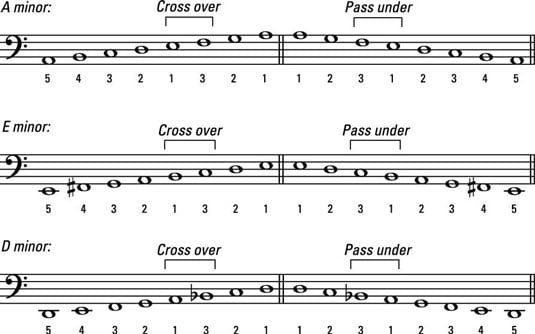
E# and F are called "enharmonic equivalents" (and so are B#/C and all the other notes which you are probably more familiar with, like Ab/G# or Eb/D# etc.) So we use E# (and not F natural) in the F# minor scale, because we have already used the letter "F" as the first and last notes of the scale. Remember that in scales, you can only use each letter name once, apart from the first and last notes of the scale. But although they are the same note on an instrument, they are different notes in music theory, and you must be careful to use the correct one. E# is the same note on the piano as F natural and B# is the same as C natural. Notice that in the F# minor scales and C# minor scales there are two notes which you might not have seen before: E# and B#. Here are all the new minor scales you need to know for grade 3 music theory. Then use the same pattern as a guide, to write out a new scale in a different key. Then write out the A minor scale and calculate whether each step is a tone (whole step), semitone (half step) or three semitones (three half steps). If you find it difficult to remember all the patterns of tones and semitones, try this method instead: learn the notes of three types of minor scale for A minor - they are easy to learn. The melodic minor has one pattern on the way up and another on the way down:.The harmonic minor has the pattern T-S-T-T-S-3S-S (3S = 3 semitones).In grade three music theory (ABRSM) you need to know two types of minor scales, the harmonic minor and the melodic minor. For grade three, you also need to know the minor scales with up to four sharps or flats in the key signature: You should already be familiar with the minor scales in the keys of A, E and D. Here is the scale of Ab major, ascending and descending in treble and bass clef:Īlso, you could just learn the word "BEAD" which spells the flats in order! If you count downwards, you get the order of flats!

The circle of 5ths works in both directions – if you count upwards, you get the order of sharps. The other new major scale we’re going to learn is Ab major.Īb has got four flats – Bb, Eb, Ab, and Db.Īn easy way to remember the order of flats is to count down five notes from the first one. Here’s the scale of E major, ascending and descending, in treble and bass clef: This is an easy way to remember the order of sharps – this is the beginning of the “circle of 5ths” (because if you keep on going, you’ll eventually end up back at the beginning!) Start at G and count up 5 notes and you arrive at D(#): Then start at C and count up 5 notes and you will arrive at G(#) Start at F(#) and count 5 notes, and you will arrive at C(#): If you look closely you’ll discover that each sharp is exactly one 5th higher than the previous one.

The first new scale in grade three music theory is E major. You should already be familiar with the scales of C, G, D, A, F, Bb and Eb major, as these are on the syllabus for grades 1 and 2 for ABRSM.Īll major scales are built using this pattern of tones (T) (whole steps) and semitones (S) (half steps): Suitable for: ABRSM Grade 3 GCSE AP Music Theory Beginners Major Scales


 0 kommentar(er)
0 kommentar(er)
